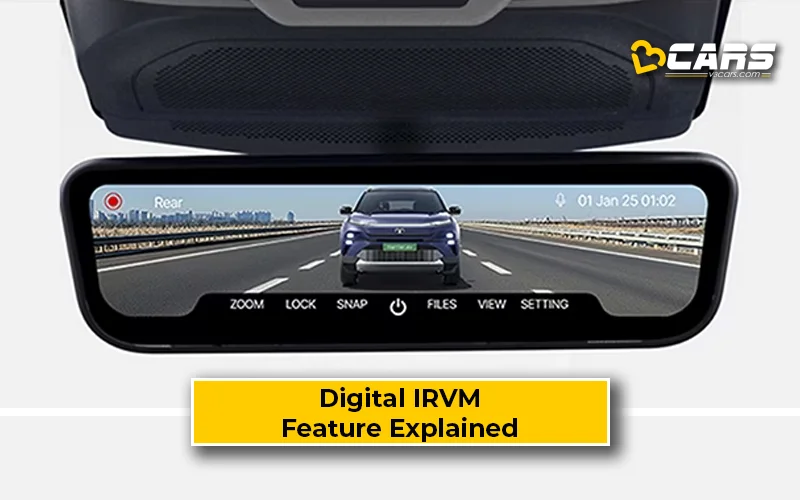Digital IRVM – Feature Explained
While traditional rearview mirrors have served us well for decades, modern automotive technology is constantly evolving to enhance safety and convenience. One such innovation is the Interior Rear View Camera or Monitor, often called a Digital IRVM (Inside Rear View Mirror) or Smart Mirror. This cutting-edge feature, which is available in the top variant of the newly-launched Tata Harrier EV, offers a superior and unobstructed view of what’s behind your vehicle.

What Is An Interior Rear View Camera Or Monitor?
An Interior Rear View Camera is essentially a digital display embedded within the casing of a traditional rearview mirror. Instead of reflecting light from the rear window, it shows a live, wide-angle video feed from a camera mounted on the outside rear of the vehicle. This system often allows the driver to toggle between a conventional reflective mirror mode and a digital display mode.
How Does It Work?
Simply put, a Digital IRVM integrates a camera with a display:
- External Rear Camera: A high-resolution, wide-angle camera is strategically placed on the exterior rear of the vehicle. In many modern implementations, like the Tata Harrier EV, this camera is located on the rear of the shark fin antenna.
- Digital Display in Mirror: The video feed from this external camera is transmitted to an LCD screen built directly into the housing of the interior rearview mirror.
- Toggle Functionality: Drivers can typically switch between the traditional mirror view and the digital camera feed with a simple flick of a switch or a touch control on the mirror unit itself. This allows for flexibility depending on driving conditions or driver preference.
- Unobstructed View: The primary advantage is that the camera’s view is not blocked by rear passengers’ heads, tall cargo stacked in the boot, or even the rear headrests. This provides a clear, comprehensive view of the road behind the vehicle at all times.
- Enhanced Clarity and Features: These digital mirrors often offer better clarity in low-light conditions, automatically adjust for glare from headlights behind, and can even include features like built-in Digital Video Recorder (DVR) or dashcam functionality to record driving footage.
What Are The Pros And Cons Of An Interior Rear View Camera?
Here are the pros, or advantages, of an Interior Rear View Camera or Monitor:
- Unobstructed Vision: Provides a crystal-clear view of the rear, regardless of passengers, luggage, or a small rear window.
- Wider Field of View: The wide-angle camera offers a much broader perspective than a conventional mirror, reducing blind spots directly behind the vehicle.
- Improved Low-Light Performance: Cameras often perform better than mirrors in poor lighting conditions, enhancing visibility at night.
- Glare Reduction: The digital display can eliminate harsh glare from the headlights of vehicles behind you, improving comfort and safety.
- Added Features: Many systems integrate DVR (dashcam) capabilities, recording the rear view, which can be valuable evidence in case of an incident.
- Enhanced Safety: By providing a superior rear view, it contributes to overall driving safety, especially when changing lanes or monitoring traffic behind.
Here are the cons, or disadvantages, of an Interior Rear View Camera or Monitor:
- Initial Adjustment: Drivers accustomed to traditional mirrors might find it takes some time to adjust to looking at a screen rather than a reflection.
- Screen Glare/Reflections: While it reduces glare from headlights, the screen itself can sometimes reflect ambient light from inside the cabin, causing minor distractions.
- Reliance on Electronics: Like any electronic system, it can be prone to malfunctions or temporary glitches.
- Higher Cost: It’s a premium feature, adding to the vehicle’s overall price.
- Requires Power: Unlike a passive mirror, it needs electrical power to function.
Can An Interior Rear View Camera Be Installed From The Aftermarket?
Yes, aftermarket solutions for digital rearview mirrors with integrated cameras are available. These systems typically consist of a replacement mirror unit that clips over or replaces your existing IRVM, along with a separate rear-mounted camera.
While aftermarket options can provide similar functionality (like a wide-angle digital feed and sometimes DVR), they might not offer the same seamless integration with the car’s electronics or advanced features such as automatic dimming as factory-fitted systems. Installation usually requires routing a cable from the rear camera to the front mirror, which a professional installer can handle.
Affordable Cars In India That Offer An Interior Rear View Camera?
As of mid-2025, the Interior Rear View Camera or Monitor is considered a premium feature and is primarily found in higher-end vehicles or advanced electric models.
- Tata Harrier EV: This electric SUV is currently the most affordable car in India to offer a digital rearview mirror
Currently, this feature is not common in truly “affordable” in India. It is expected to trickle down to more segments as technology becomes more cost-effective, but for now, it remains a differentiator for higher-tier and technologically advanced vehicles.
Also Read: Hill Start Assist Or Hill Hold Control - Feature Explained
Helpful Tools:
- Fuel Cost Calculator for Cars – Know your monthly fuel expense based on usage and mileage
- Car On-Road Price Calculator – Convert ex-showroom to on-road price for any city
Sell Used Car Online – Enter your car and contact details to get an instant price estimate and book a free inspection with our partner network


0 Comments